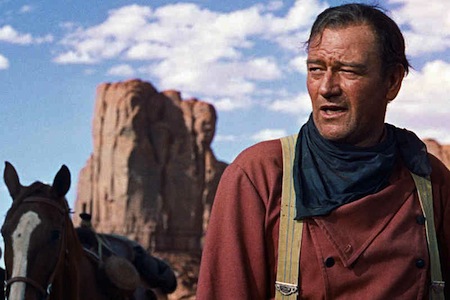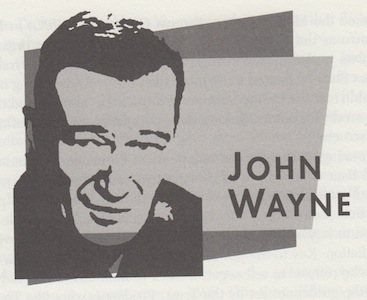Born: May 26, 1907, Winterset, IA
Died: June 11, 1979, Los Angeles, CA
There is no one who more exemplifies the devotion our country, its goodness, its industry and its strengths than John Wayne.
—Ronald Reagan
For nearly seventy years, the personality of John Wayne has shaped the moral code of the western genre and dominated the spirit of American moviemaking. His legendary persona exemplified both the law of the Old West and the politics of the Cold War. In movie theaters, he became the ideal patriot to millions of children and adults. Beyond the screen, he stood as a symbol of the righteousness and fortitude of America for the rest of the world. More than poets or presidents this actor became the most effective ambassador the United States ever had, appearing before millions of people in hundreds of countries, disseminating a vision of the American ideal through his immensely popular films. No other man ever embodied the values of an entire country as succinctly as John Wayne.
Wayne began his film career as Marion Morrison, a young college football star who found work doing odd jobs at the William Fox studio in the late 1920s. Soon, he changed his name to the more masculine John Wayne and captured several bit roles in serial westerns. Though his first big break came when director Raoul Walsh gave him the lead in The Big Trail (1930), Wayne spent most of the decade in low-budget horse operas until a reluctant John Ford was persuaded to cast him as the Ringo Kid in Stagecoach (1939). The film raised the sophistication level of westerns by incorporating strong ensemble characterizations and daringly realistic action sequences into the standard cowboys-and-Indians formula. Stagecoach was a widespread success and brought much attention to the easygoing grace of the young Wayne, making him an instant action hero.
Although famous for his saddle work, Wayne would also lay a foundation for his legend during the 1940s playing a string of tough sergeants, brave aviators and marine commanders in wartime classics such as Flying Tigers (1942), The Fighting Seabees (1944) and Back to Bataan (1945). These roles were critical to the development of John Wayne’s public image during World War II, for they brought his patriotism into the present day and allowed homefront moviegoers to attach a heroic face to the American soldiers fighting in foreign lands.
As a Hollywood commodity, Wayne was a unique box office phenomenon. At least one of his films finished in the top ten every year between 1949 and 1972. And though his rolling gait and likable manner were mainstays, he wasn’t afraid to explore off-type roles and keep his work fresh. Movies like Red River (1948) and The Searchers (1956) gave him opportunities to explore darker themes and present himself as an antagonist. He made noble attempts in romantic comedies and costume dramas, sometimes playing the unlikely barbarian or Roman; even drawling through the role of Mongolian emperor Genghis Khan in the critical flop The Conqueror (1956) could not tarnish his box office crown.
Still, the Wayne persona would remain most powerful and consistent in westerns. Under the care of director John Ford, who nicknamed the actor “Duke” and hoisted him back in the saddle, he made a long string of stellar films set in the picturesque landscape of Arizona’s Monument Valley. Through three decades, Ford cast Wayne in such outstanding films as Fort Apache (1948), She Wore a Yellow Ribbon (1949) and The Man Who Shot Liberty Valance (1962), ultimately redefining the western genre and molding Wayne into an American icon. John Wayne made only thirty-one westerns, but in these roles he established the code of the screen hero—free, fair, decisive and determined. His man-of-action was a rugged individualist who said what he meant and was ready to defend his words. Previous western heroes lacked these governing rules, and the western actors that followed were obliged to stay within the moralistic boundaries that audiences found so appealing in Wayne’s performances.
Off-screen, his personality was neither rigid nor brash. An affable man with a self-effacing sense of humor, John Wayne spent his private time in quiet leisure, preferring the serenity of sailing to the raucous parties of Hollywood. When he wasn’t relaxing, he honed his craft by tirelessly rehearsing. The monologues that seemed to roll effortlessly off his lips on film were in fact the result of laborious practice. Wayne’s neighbors recalled seeing him spend long sessions in the backyard of his home, wandering the length of the property with a script in hand, memorizing his lines and repeating even the smallest phrase hundreds of times to determine the appropriate delivery.
Eventually the line between his personal views and his screen image blurred beyond recognition. His active membership in organizations like the Motion Picture Alliance for the Preservation of American Ideals allowed him to use his celebrity to further causes he deemed worthy. In the 1950s, Wayne joined Walt Disney, Clark Gable and other entertainers to assist U.S. Senator Joseph McCarthy and the House Un-American Activities Committee in exposing Communists working in the film industry. He began hand-picking roles and financing the production of certain films, like the heavy-handed Big Jim McLain (1952), which made overt anti-Communist statements. These “message films” would often cost him, both personally and professionally; Wayne lost a small fortune on the Vietnam War film The Green Berets (1968), allowing an errant sense of patriotism to oversimplify the story of soldiers conducting covert military actions in Southeast Asia. As television images exposed the horrors of battle to Americans, the film’s romantic portrait of “gung-ho” optimism was often cited as an example of how completely out of touch Wayne and many of his conservative contemporaries were with the complexities of the conflict.
Many of his critics felt John Wayne became encircled by his own legend and behaved as if he were truly the renegade he often portrayed in the movies. In a telltale example of Wayne’s forcefulness, he virtually willed into being the Academy Award nominations for The Alamo (1960), a film he directed himself. Alamo was not an especially deserving piece of work; many people felt Wayne produced the project as a way of giving himself the heroic role of Davy Crockett. When rumors circulated that the Academy would pass the picture over, Wayne became enraged. He felt that Alamo was an important film, because it espoused American ideals in the midst of rampant Communism, and should be included as a Best Picture candidate. He enlisted the help of Russell Birdwell, the public relations showman who had successfully staged the search for the perfect Scarlett O’Hara in anticipation of Gone with the Wind. Wayne and Birdwell figured out that votes from just a few hundred of the Academy’s two thousand members would swing a nomination. Targeting the 180 publicists in the voting body, Wayne drafted a 183-page press release that appealed to their patriotic side, and he spent $150,000 of his own money on an unprecedented campaign that placed hundreds of ads in trade dailies over several months. His persistence paid off; The Alamo received six nominations, including one for Best Picture. Many in Hollywood felt Wayne’s personal crusade undercut the chances of such worthy films as Inherit the Wind, Psycho, Spartacus and Exodus, none of which were nominated. However, the campaign became the blueprint for Oscar-stumping, and today’s studios follow Wayne’s plan to the letter, spending heavily on slick marketing campaigns to bolster the chances of winning a statuette, which can instantly double an actor’s salary and add an estimated $25 million to the grosses of a film.
One of the hardest-working actors of his day, John Wayne made ninety-three films and was still in demand as a leading man well into middle age. Just as audiences felt he was becoming a pathetic has-been, he playfully poked fun at his own image in True Grit (1969). The role of the craggy curmudgeon Rooster Cogburn would bring Wayne his first Oscar at age sixty-two. A few years later, he gave his final performance, as a dying gunman in the elegiac The Shootist (1976), a painful reminder that Hollywood’s greatest cowboy and film’s most splendid genre were both passing.
Among cinematic icons, Wayne looms above all but Charlie Chaplin as an instantly recognizable international symbol of movies and a consistent box office champion. He was to the western what Chaplin was to silent comedy, what Alfred Hitchcock was to suspense and what Lon Chaney was to horror. In fact, so pervasive is the influence of John Wayne on the cowboy picture that it’s close to impossible to separate one from the other. It is equally difficult to recall the history of the American West without summoning many of the dramatic overtones that are present in the Duke’s memorable performances.
To read all the republished articles from ‘The Film 100,’ go to Reintroducing the Film 100 here on Keyframe.





